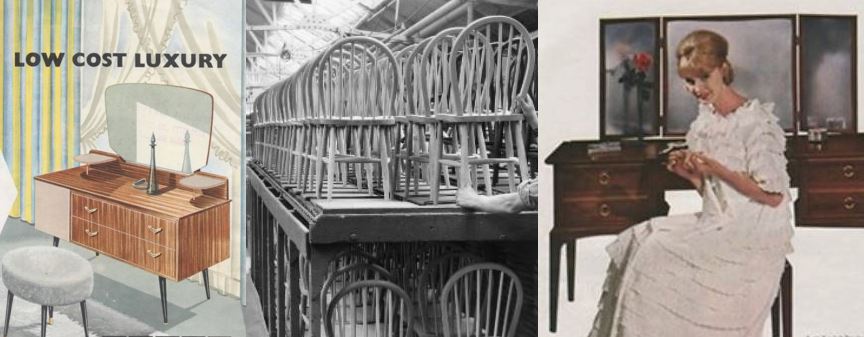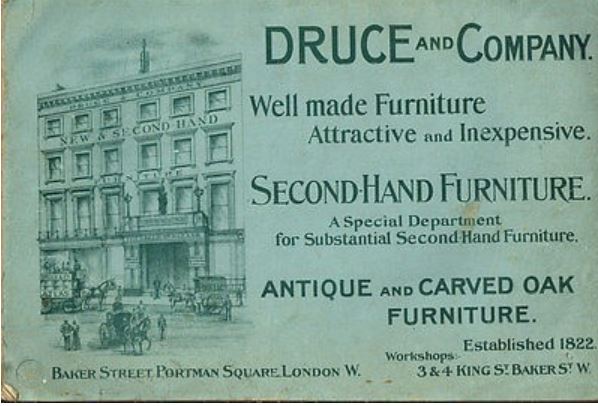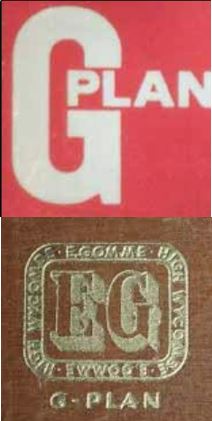Your basket is currently empty!

Furniture is more than functional and practical; it is a product of design, a work of art. During my own upcycle journey, certain brands – some well known, others less so – have graced my workshop. Here I have looked into each brand a little more deeply plus plagiarised a touch from other sites and added examples of my own upcycled furniture pieces.
Jentique
My favourite brand of bureau and they made the first ever piece I sold commercially. Jentique was established in the early 1930s by Geoffrey Bowman Jenkins, a successful toymaker and inventor of the not-so-successful water driven hydraulic toothbrush the Kavor, and his wife Edith. Aged 20 he lived in Luton, just over the county border from me before moving to Dereham, Norfolk where Jentique was created. Jentique are known for their heavily carved bureaus which are rather art-deco in style. Jenkins lost Jentique to his business partner in 1936 and in later years, the company followed the trend for Danish design specialising in modern contemporary furniture. Jentique pieces are quite uncommon so were probably made and sold in small batches within the UK.



Stag
A mass-market manuracturer who never hid the fact their furniture was not handcrafted, but machine made. Chief designer duo, John and Sylvia Reid, created a number of ranges for Stag from the early 1950s focussing on elegant, modern thinking and value. Cumberland – the ‘C’ range – was stark; no handles just recesses, straight boxes with low legs. And cheap. Their slogan was “For the young in heart and in pocket“. Despite a slow start, 1957 saw £500,000 p.a. in sales and continued to have a strong influence in furniture design in the 1950s. They never faltered in quality and their subsequent Madrigal range was modern yet based on 18th Century simple elegance. In 1960, Stag launched a dining room collection which set them apart from competitors. It included a seemingly 10′ sideboard in teak veneer on slender satin finished steel legs which was assembled in units. It was adaptable, suitable for smaller rooms and was inexpensive for the quality it offered.
In 1964 the Minstrel range became probably the best selling furniture range in the UK – ever – as was in production for over 40 years. It represented the very best of British mid-century design Stag’s quantity buying of timber and efficient production meant no other manufacturer could offer similar designs at the same price. Below is an advert for a Minstrel dressing table and a before and after photo of a piece I have recently upcycled.



Nathan
B&I Nathan, established in 1916, produced contemporary furniture in the 1950s, 1960s and 1970s. They traded in quality, craftsmenship and value. Originally a follower rather than a trendsetter, their 1950s dark wood furniture with brass handles was popular at that time yet Nathan did not move from that style until 1963. They then embraced the Skandi style of long, low sideboards; simple and elegant with no decor. Theirs was a foot smaller than their furnituremaking counterparties’ which was much more suitable for a semi-detached home and therefore, more marketable. Later in the 1960s they moved more up-market with their designs in teak. The 1970s saw a more Jacobean feel to their modern teak, typically suburban style and it is this style which I see upcycled frequently today – the one with the rectangular panels.



Lebus
The company’s history began as early as the 1840s when Louis Lebus, a Jewish immigrant cabinet-maker, came to Britain from Germany. However, it was his son, Harris, who took over in 1879 and by the 1890s turned Lebus into the largest furniture manuracturer in Britain. Early designs were typical of the arts and craft movement and Lebus brought that genre to the masses. Early 20th century saw Lebus assist the government with WWI supplies making ammunition boxes and aircraft frames and then in WWII replica Sherman tanks – made from wood! Post-war saw Lebus move from a family firm to a Plc but with many family members staying on the board. They were part of the government’s scheme to make utility furniture available to newly-weds or to those who had lost their belongings during bombing raids. Their focus was on increased mechanism, high volumes of well constructed affordable furniture, despite raw materials still being rationed. During the 1960s, the factory gradually fell into decline and with poor management, closed its doors in the year of my birth: 1969.



Ercol
Founded by Italian Lucian Ercoloni in the 1920s, Ercol’s simple goal was to make furniture that was well designed and made in a good working environment by craftsmen who really took pride in their jobs. Lucian was invited by the Parker brothers (later Parker-Knoll) to leave London and join them in High Wycombe, just north of the county where I live. He became friends with Ted Gomme (latterly of G-Plan fame) and went on to set up Ercol in the 1920s. After taking over a respected firm of high-class chairmakers, [Walter] Skulls, Ercol went on to supply the government with wartime supplies such as wooden pegs and ammunition boxes, they then joined the government’s Utility Furniture Scheme with their efficient use of scarce timber. The Board of Trade commissioned 100,000 mass produced low-cost chairs so in 1948 Ercol showcased their Windsor collection at the Britain Can Make It Exhibition and it quickly become synonymous with Ercol furniture. Their favourite wood was English Elm which was shunned by other manufacturers but Ercol managed to steam bend it for their chairs. Their furniture was light and modern, rather than the dark and chunky pre-war styles, despite their traditional origins.
After exhibiting at the Festival of Britain in 1951 there came the Loveseat, the Studio Couch, Butterfly Chair, the Stacking Chair and Pebble Tables (still in production since 1954). In 2002 the factory moved down the road to Princes Risborough and it has won environmental awards as their heat and hot water are derived from wood waste, no solvent stains or lacquer are used and their style means seat pads are easily replaced ensuring the chair’s longevity. Fourth-Generation family members are still involved in running Ercol.



Druce & Co of Baker Street
In early Victorian times, Druce & Co furniture would grace fine homes of those of note. Druce would also be dealing in high quality old pieces to which they would have attached their trade lable hailing from their secondhand department. It was established in the Marylebone area of London, on the corner of Blandford Street and Baker Street in the mid-19th century on the site of the previously named ‘Baker Street Bazaar’. Thomas Charles Druce collated and displayed fine furniture from skilled makers throughout the globe. His son, Herbert, was an integral part of the business – taking over the running in 1864 when Thomas passed away. With a keen eye for quality, the Druce & Co company traded successfully throughout the Victorian and Edwardian eras, the Great War, and into WW2 when, at the end of 1940, German bombers destroyed most of the building and stocks.



Minty of Oxford
Founder Norman Minty, born in Oxford in 1860, opened his first shop on the High Street when he was 20. His wicker chair, known as the Varsity, quickly became a must-have item and it was said that every undergraduate in Oxford had one. During WWI, Minty made canvas goods for the armed forces, including stretchers and tents. Minty continued to make tents and marquees and set up a subsidiary department dealing in the hire of these after the war. Minty shops were opened in London in 1920 and Manchester in 1932 but again, during WWII they produced tents, aircraft covers, mobile repair units and various items of wooden equipment.
Mr Minty, who died in 1934, was succeeded as chairman by Mr B B Bowles, who had joined the firm as a junior and had risen to managing director. The Minty family link was maintained by Mr Minty’s son, Edward, who became the general manager. But in 1992, in the face of difficult trading conditions, the firm went into receivership. Two years later, it was sold for £1.1m to rival Cornwell Parker and the factory was closed, ending more than a century of Minty production in Oxford.




Worth and Smith
Cabinet manufacturers, upholsterers and undertakers. What a range of offerings! Based in Bournmouth at the turn of the century, I have very little information on this firm except an advert and a piece of furniture which I upcycled. It was beautifully used with fantastic patina gleaned from life, grime and cigarettes left alight on the taple top. My upcycling did not remover the traces of its history, simply embellished it.


Original Chippy Heath
Original Chippy Heath furniture were also a High Wycombe family based firm, established in the 1960s by Eric Heath then succeeded by his son, Garry Heath. They specialised in telephone seats in ‘Louis, Regency, Jacobean, Modern and Contemporary designs’. A video from 1980s shows inside the factory as the telephone seats were being made plus give a little history of the firm and its founders.


G-Plan
Gomme’s was founded in High Wycombe in 1898 by Ebeneezer Gomme although there is mention of a James Gomme, a furniture maker operating in High Wycombe from 1798. Initially they produced hand-made chairs before building their first factory and by 1922 they employed 300 people. From 1943, during WWII, they made aircraft frames and manufactured parts for the De Havilland Mosquito. Between the wars, Gomme’s were the first to introduce the concept of the dining room suite. By 1938 Gomme’s employed 800 people and was one of the country’s biggest furniture manufacturers.
As with other furniture makers of the time, Gomme’s were part of the Government’s Utility Scheme which ran from 1941 to 1952 and limited the types and cost of furniture on sale. In 1947 Gomme’s exhibited at the British Industries Fair as “Manufacturers of Antique Reproduction Furniture, Bedroom, Dining Room, Drawing Room Furniture, Upholstered Furniture”. 1953 saw the creation of the brand “G-Plan” from the Gomme Plan: a plan for living. The G-Plan range appeared just at the right time – when consumers wanted a change from the limited choice of the utility furniture of WWII and the dark brown, chunky furniture of earlier decades. G-Plan’s light oak furniture was stylish, attractive, adventurous and had a contemporary feel. It could also be bought a piece at a time and was designed for the entire house.
Gomme’s introduced direct marketing and showrooms “The G Plan Gallery” where the public could see the furniture. In the 1960s, restrictions on higher purchase were introduced. This, along with the trend towards Danish design which rendered their existing lines seems outdated, led to G-Plan’s loss of their market leading position. In 1987 the Gomme family – major shareholders in the company – decided to retire. In 2005, G-Plan was acquired by Sofa Brands International which is also a holding company of Parker-Knoll. Cabinet manuracturing ceased in 2015 although the upholstered furniture is still made in Melksham, Wiltshire.



High Wycombe – the furniture making epicentre
The craft of making chairs in the Chilterns dates to before 1700 where “turners” were registered within the parish. There was a vast quantity of Beechwood in Buckinghamshire, more plentifully than in any other part of England, which was used for chairmaking. The earliest references to Windsor chairs (Ercol’s signature piece) date from 1732 “Wins. chair ordered by the Vestry” which is believed to be a reference to a Windsor chair. When a list was drawn up 60 years later in 1798 for military service purposes, more than 50 chairmakers were recorded as living in the borough and parish of High Wycombe and West Wycombe, with many more in the villages around.
There is also reference to James Gomme (possibly of G-Plan heritage) in 1798. A Heals auctioneer’s lable of the time states “SOLD at the original Upholstery Warehouse of James Gomme, in High Wycombe, where Cabinet Work is done, and Orders for Household-Furniture of every Description executed in the best, and most fashionable Manner, 1798.” It is not confirmed whether this particular Mr Gomme, a furniture maker in High Wycombe, was related to Ebeneezer Gomme of Gomme’s and latterly G-Plan, although it is highly probable.
From the earliest days of the trade most of the lathe-turned chair parts were made by travelling turners or “bodgers“. The use of the term bodger to describe these craftsmen is probably from the 20th century, and certainly was not used during the 1840s and 1850s when the number of turners working in the Chilterns reaches its peak. Between the years 1800 and 1860 the number of workshops in High Wycombe grew from a handful to 150 and by 1875 their total output had risen to an estimated number of 4,700 chairs per day – a remarkable figure. The area in and around High Wycombe became the biggest producer of chairs in the country, and between 1851 and 1871 the population of High Wycombe borough and parish grew by 46%. Parliament unfairly stated that Wycombe chairs were “cheap and nasty” so a number of manufacturers began in the 1880s to diversify into making higher-class and more general furniture. By the end of the 1890s, some of the larger East London furniture makers, such as Frederick Parker (later Parker Knoll), moved to High Wycombe and contributed to the change to a more broad-based furniture trade.
Designs towards the end of WWII, and immediately after, were strongly influenced by the Government imposed Utility Scheme lasting ten years from 1941. Demand for domestic furniture was high, but the trade had its materials rationed. Most companies produced furniture within the Utility range, while a small number of luxury orders kept higher class factories going. Shortages eased and controls were lifted over time. The advent of hire purchase opened the floodgates of consumer demand and the 1950s were prosperous years. National advertising became an option in 1951, and Ercol and Gomme’s joined Parker Knoll in this new venture. New designs, products and systems were introduced: Ercol took up the Windsor theme looking for new ideas of quality; Gomme brought out the G-Plan range, a series of coordinating furniture units that could be bought individually. The number of furniture workers had fallen from 10,000 in 1939 to 8,000 by 1960 and the relocation of many London companies to High Wycombe during the War had caused property prices in the area to soar, making it more and more expensive to maintain factories locally and forcing some of the biggest to move elsewhere. Advances in wood treatment and mechanisation raised output per man so that production figures continued to rise, although employment continued to fall to approximately 4,000 in 1990. For the workers who remain, the introduction of machinery such as spray booths, which extract harmful vapours given off by sprays and polishes, and other improvements, have made the furniture factory a much more healthy environment than it once was.
The 1990s saw much change with the recession claiming the huge G-Plan factory in 1992 with the loss of 700 jobs; the closure and subsequent demolition of Glenisters, the oldest surviving furniture making company in High Wycombe; and the decision by Parker Knoll to stop making furniture in High Wycombe. In 1999, High Wycombe’s largest furniture maker, Ercol, announced that it was moving to Princes Risborough although that was just a few miles down the road. High property prices continued to encourage firms to relocate in cheaper areas. However, the roots of the furniture industry run deep in the town, enough to ensure that furniture will continue to be made in High Wycombe for many years to come.
Chair Arches
The High Wycombe chair arch is a particularly notable celebratory tradition which dates back to the Victorian era. The first chair arch, orchestrated by Walter Skull (whose firm was later taken over by Ercol) was created in 1877. This initial chair arch was constructed to mark Queen Victoria’s visit to Benjamin Disraeli at Hughenden Manor. At the bottom were common Windsor and cane-seated chairs, rising through drawing-room, lounge, library, reading, rocking and other seats, to the State chair of the Mayor, covered with red velvet and bearing the gilded crest of the Borough. The largest chair arch assembled in 1884 contained approximately 400 chairs and was erected to mark the visit of the Prince of Wales. Several chair arches have been created since: in 1962 an arch featuring modern chairs was assembled in High Wycombe’s townhall to greet Queen Elizabeth II, and in 2000, a millennium chair arch was made to celebrate the town’s contribution to the furniture industry. This structure recreated the chair arch originally built 110 years prior. It was over 9 meters high and featured more than 150 chairs of traditional design.


Please forgive any historical anomolies – I would rather you got in touch and put me straight so I can correct this blog post. Thank you.

Leave a Reply